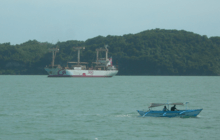2GO Group
 Current 2GO Logo, 2013 | |
| Industry | Transport and Logistics Services |
|---|---|
| Founded | Aboitiz |
| Headquarters |
12th Floor, Times Plaza Building United Nations Cor. Taft Aves. Ermita, Manila, Philippines 1000 |
| Revenue | $330M |
Number of employees | 1,005 |
| Website |
2go |


2GO Group Inc. is a Philippines-based company engaged in transporting people and cargo using the fleet of inter-island ferries and cargo ships of the former ATS (Aboitiz Transport System)–-which owned the brands SuperFerry, Cebu Ferries and SuperCat—and Negros Navigation. The China-Asean Investment Cooperation Fund, an investment fund set up by the Chinese government, is the controlling stockholder.[1][2]
The company has the largest infrastructure in the Philippines with over 400,000 TEU capacity (approximately 50% market share of domestic Philippine freight), 16 passage and freight vessels, 15,000 containers, 35 warehouses nationwide, 550 trucks, and 7,000 employees.[3]
Company history
The first precursor company to 2GO Group Inc. began on May 26, 1949. Eventually, the Aboitiz Transport System was formed by, first, the breakup of WG&A SuperFerry into SuperFerry and Carlos A. Gothong Lines and then the merging of SuperFerry with Cebu Ferries and SuperCat fast ferries to form the Aboitiz Transport System.[4]
In December 2010, the former major stockholders of the company, namely Aboitiz Equity Ventures and Aboitiz and Company Inc. sold their shares to Negros Navigation Co. Inc. (NENACO), for US$105 million.[4] The equity value included all the logistics and shipping businesses of the company, except its interest in its joint ventures with the Jebsen Group of Norway.
At the same time, December 2010, Negros Navigation announced that the China-Asean Investment Cooperation Fund acquired a controlling stake in the company through an equity infusion. The China-Asean Investment Cooperation Fund is a Netherlands-based,[lower-alpha 1] private equity firm wholly owned and controlled by the Government of the People's Republic of China.[2][4][6] Because Negros Navigation was a privately held firm the exact amount invested by the Fund was not disclosed.[1] In short, the mainland Chinese government set up the China-Asean Investment Cooperation Fund, which then among other investments in the region took a controlling stake in Negros Navigation, which in turn purchased SuperFerry and related brands and re-branded itself 2GO Group.
Operations
As of December 31, 2011, the shipping fleet owned by the company and its subsidiaries reached 29 operating vessels, of which 19 were company-owned. The fleet consists of: 8 fast crafts, 12 roll-on/roll-off (RoRo)/passenger vessels (three of which are time-chartered from the parent company, NENACO) and 9 freighters (3 of which are time-chartered from NENACO and 4 from MCCP). The total combined gross registered tonnage is 204,140 metric tons, total passenger capacity of approximately 20,360 passengers and aggregate cargo capacity of approximately 6,059 twenty-foot equivalent units (TEUs).
Notes
References
- 1 2 "Chinese firm to become top Philippine ferry operator". ABS-CBN News. 12 May 2010. Retrieved 3 February 2013.
- 1 2 Gamboa, Rey (August 20, 2013). "Keeping our seas safe". Philippine Star. Retrieved 12 September 2013.
- ↑ "Company Profile". Official Website. 2GO Group. Retrieved 4 February 2013.
- 1 2 3 Cacho, Katlene O. (December 1, 2010). "Aboitiz sells transport unit". Sun Star Cebu. Retrieved 3 February 2013.
- ↑ "Contact Info". Official Website. China-ASEAN Fund. Retrieved 2 September 2013.
- ↑ "Negros takes out remaining Aboitiz stock". Baird Maritime. 7 January 2011. Retrieved 3 February 2013.